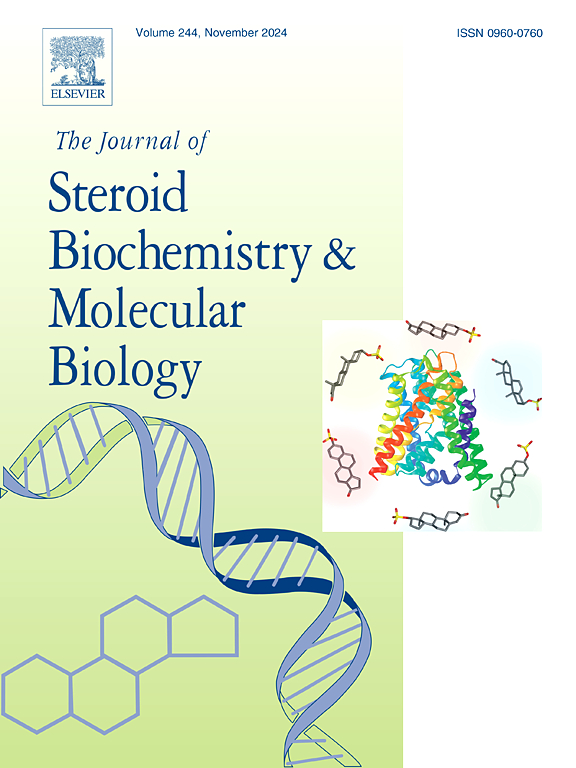非常高剂量的维生素D₃可以减少健康猪体内参与β-氧化的基因和蛋白质的表达
IF 2.5
2区 生物学
Q3 BIOCHEMISTRY & MOLECULAR BIOLOGY
Journal of Steroid Biochemistry and Molecular Biology
Pub Date : 2025-07-16
DOI:10.1016/j.jsbmb.2025.106835
引用次数: 0
摘要
维生素D在人体中起着多方面的作用,影响着广泛的生理过程。虽然它对缺乏维生素D的人的好处已经得到了充分的认识,但对维生素D充足的人补充高剂量维生素D₃的影响仍然知之甚少。在这项研究中,我们应用了综合转录组学和蛋白质组学方法来评估健康猪的长期膳食维生素D₃补充(5000和10000 IU/kg饲料)的剂量依赖效应。尽管增肥特征没有表型改变,但我们观察到肝组织中显著的分子变化,特别是在脂肪酸β氧化、氨基酸分解代谢和氧化应激反应相关的途径中。高剂量补充维生素D₃导致参与线粒体和过氧化物酶体β-氧化的关键基因和蛋白质的持续下调,包括ACSL5、ACADVL、HADHA、ACAA1(基因表达)和ACADM、ECHDC1、ECHDC2(蛋白质水平)。这些发现表明,肝脏激活和降解长链、超长链和中链脂肪酸的能力降低,可能导致脂质中间体的积累,并向替代代谢途径转变。我们的研究结果表明,在非缺乏状态下,非常高剂量的维生素D₃补充可能会导致肝脏的不良代谢变化,包括脂质积累和能量代谢受损。这些影响似乎是剂量依赖的,虽然它们可能不会在短命物种中表现出表型,但它们为高剂量维生素D₃补充剂的非经典毒理学效应提供了重要的见解。重要的是,这项研究强调了维生素D作用的环境依赖性,并为关注其在经典途径之外的代谢作用的研究提供了一个新的方向。本文章由计算机程序翻译,如有差异,请以英文原文为准。
Very high-dose vitamin D₃ supplementation reduces the expression of genes and proteins engaged in β-oxidation in healthy pigs
Vitamin D plays a multifaceted role in the body, influencing a wide range of physiological processes. While its benefits in deficiency states are well recognized, the effects of high-dose vitamin D₃ supplementation in vitamin D-sufficient individuals remain poorly understood. In this study, we applied an integrative transcriptomic and proteomic approach to assess the dose-dependent effects of long-term dietary vitamin D₃ supplementation (5000 and 10,000 IU/kg feed) in healthy pigs. Despite the absence of phenotypic alterations in fattening characteristics, we observed significant molecular changes in liver tissue, particularly in pathways related to fatty acid β-oxidation, amino acid catabolism, and oxidative stress response. High-dose vitamin D₃ supplementation led to consistent downregulation of key genes and proteins involved in mitochondrial and peroxisomal β-oxidation, including ACSL5, ACADVL, HADHA, ACAA1 (gene expression), and ACADM, ECHDC1, and ECHDC2 (protein level). These findings suggest a reduced hepatic capacity for activating and degrading long-, very long-, and medium-chain fatty acids, potentially resulting in the accumulation of lipid intermediates and a shift toward alternative metabolic pathways. Our findings indicate that very high-dose vitamin D₃ supplementation in non-deficient states may lead to adverse metabolic shifts in the liver, including lipid accumulation and compromised energy metabolism. These effects appear to be dose-dependent, and while they may not manifest phenotypically in short-lived species, they offer important insights into non-classical toxicological effects of high-dose vitamin D₃ supplementation. Importantly, this study highlights the context-dependent nature of vitamin D’s effects and provides a new direction for research focused on its metabolic roles beyond classical pathways.
求助全文
通过发布文献求助,成功后即可免费获取论文全文。
去求助
来源期刊
CiteScore
8.60
自引率
2.40%
发文量
113
审稿时长
46 days
期刊介绍:
The Journal of Steroid Biochemistry and Molecular Biology is devoted to new experimental and theoretical developments in areas related to steroids including vitamin D, lipids and their metabolomics. The Journal publishes a variety of contributions, including original articles, general and focused reviews, and rapid communications (brief articles of particular interest and clear novelty). Selected cutting-edge topics will be addressed in Special Issues managed by Guest Editors. Special Issues will contain both commissioned reviews and original research papers to provide comprehensive coverage of specific topics, and all submissions will undergo rigorous peer-review prior to publication.

 求助内容:
求助内容: 应助结果提醒方式:
应助结果提醒方式:


